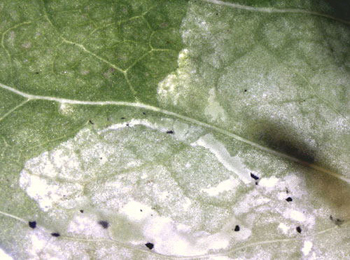|
||||||
| Agromyza
lathyri Hendel, 1923 [Diptera: Agromyzidae] |
||||||||||||||||||||||||||||||||||||||||||||||||||||||||||||||||||||||||||||||||||||||||||||||||||||||||||||||||||||||||||||||||||||||||||||||||||||||||
|
Calyptomyza
atra Hardy, 1850a. The North British Agriculturalist and
Journal of Horticulture. 3rd Aug. 1850: 486. [Preoccupied
by Agromyza atra Meigen, 1830, now Cerodontha (Poemyza)
atra (Meigen, 1830)] |
||||||||||||||||||||||||||||||||||||||||||||||||||||||||||||||||||||||||||||||||||||||||||||||||||||||||||||||||||||||||||||||||||||||||||||||||||||||||
Leaf-miner: An initially lower-surface linear leaf-mine, which later develops into large whitish blotch and appears pale and mottled from above, due to the variable depth of larval feeding. Less frequently feeding in upper surface or stem (Spencer, 1972b: 37, fig. 112); Spencer, 1976: 118). The mine starts as a superficial lower-surface corridor. After its first moult the larva starts making a blotch, often close to the base of the leaflet. The blotch in principle is lower-surface, but may be interparenchymatous for some part. Moreover, in places the larva feeds from the palissade parenchyma. Seen from above the leaf appears mottled. The overall result is that the mine, despite its considerable size, is hard to find. The easiest way is to hold the leaves against the light: the large larvae than are conspicuous. Frass in coarse grains, both in the corridor and in the blotch; in the corridor they are widely spaced. Pupation outside the mine (Bladmineerders van Europa). Larva: The larvae of flies are leg-less maggots without a head capsule (see examples). They never have thoracic or abdominal legs. They do not have chewing mouthparts, although they do have a characteristic cephalo-pharyngeal skeleton (see examples), usually visible internally through the body wall. The larva is described by Darvas, Skuhravá and Andersen (2000), de Meijere (1926) and in Bladmineerders van Europa. Puparium: The puparia of flies are formed within the hardened last larval skin or puparium and as a result sheaths enclosing head appendages, wings and legs are not visible externally (see examples). Reddish (Bladmineerders van Europa); posterior spiracles each with up to 40 bulbs on a black conical projection (Spencer, 1976: 118, fig. 196). Hosts in Great Britain and Ireland:
Hosts elsewhere:
Time of year - mines: June-August. Time of year - adults: Currently unknown. Distribution in Great Britain and Ireland: Kent (New Cross), Surrey (Kew) (Spencer, 1972b: 41), Warwickshire (Coventry) (Robbins, 1991: 46) and Cambridgeshire (NBN Atlas). Distribution elsewhere: Widespread in continental Europe including Denmark, Germany, Holland, Italy (Spencer, 1976: 118), Corsica, Czech Republic, French mainland, Lithuana, Poland, Romania, Spanish mainland, Sweden and The Netherlands (Fauna Europaea). NBN Atlas links to known host species: British and Irish Parasitoids in Britain and elsewhere:
|
|
|
|
| External links: | Search the internet: |
|
Biodiversity Heritage Library Bladmineerders van Europa British leafminers Encyclopedia of Life Fauna Europaea NBN Atlas NHM UK Checklist |
Find
using Google Find using Google Scholar Find images using Google |
| Last updated 07-Oct-2019 Brian Pitkin | ||

